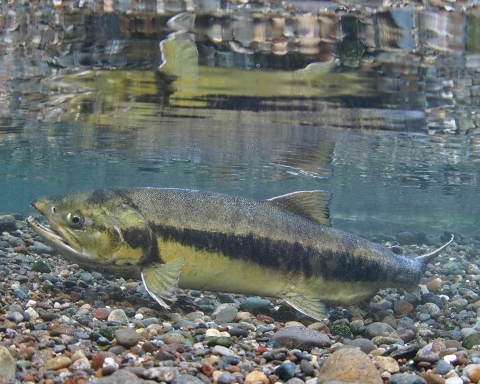Quinault National Fish Hatchery, in the shadow of Olympic National Park, raises and releases approximately three million fish annually. These include Coho and Chum Salmon as well as Winter-run Steelhead Trout. This facility is co-managed by the Quinault Indian Nation, with a primary mission to fulfill the United States treaty obligations. Fish release from this hatchery also benefit the local sport and commercial fisheries as well.
About Us
Since 1871 the National Fish Hatchery System has worked to restore aquatic species that are important to the health of our aquatic systems. This country-wide network of national fish hatcheries works with states and tribes to conserve, restore and enhance the fish and aquatic resources of America for future generations.
The Quinault National Fish Hatchery grew out of the cooperation between U.S. Fish & Wildlife Service and the Quinault Indian Nation, in an effort to restore and enhance the depleted salmon and steelhead fish runs on the Quinault Indian reservation and adjacent lands. Species and quantity reared as well as release times are subject to change based on hatchery evaluation findings, fisheries research, environmental conditions, and consensus between the USFWS managers and the Quinault Indian Nation. Coho and Chum Salmon, along with Winter-run Steelhead Trout, are currently being reared and released at this facility.
What We Do
The Quinault National Fish Hatchery releases approximately three million young chum salmon, coho salmon and winter steelhead annually. The process of spawning adults, incubating eggs, rearing fry, marking and tagging fry, and releasing millions of fish each year requires dedicated year-round work from our hatchery staff, hatchery evaluation team, and fish health veterinarians. Please visit our Fish Production Cycle Page for a more detailed description of the work we do.
Our Organization
Our Species
Chum salmon: (O. keta) The majority of these fish rush to the hatchery the first two week in November. Female and male adults ready to spawn once they reach the hatchery. About 650 females are needed to collect enough eggs for a fry release of 2.15 million! Once the fry are liberated from the incubation trays, they are fed for about 40 days and then released into Cook Creek. Returning adult Chum salmon range in ages from 3 to 5 years.
Coho salmon (Oncorhynchus kisutch): We also raise and release around 650,000 coho salmon per year. The number of 2 to 3 year-old adults who return to the hatchery each year varies, ranging from a few hundred to over 10,000. Baby coho salmon, or "fry", emerge from incubators in February and remain in our care until late spring, when we release them into the upper Tsoo-Yess River. These fry will spend an additional year in the river before migrating out to the ocean. Adults begin their migration back to the hatchery as early as September of each year.
Winter-run steelhead: (O. mykiss) Quinault NFH also raises and releases 200,000 winter-run steelhead for the Quinault Indian Nation. These fish provide important commercial and subsistence fisheries to tribal members and offer quality tribal-guided sport fishing opportunities available to the general public. Yearlings (smolts) are released directly from the rearing ponds into Cook Creek . Adult Steelhead trout begin returning to the hatchery in November and continue to return until January.
Visit Us
Located in the beautiful Olympic Peninsula, Quinault National Fish Hatchery is a popular tourist destination in the area. Our self-guided visitor center provides helpful and interesting information about our hatchery operations, the fish we rear, and their cultural relevance to the Quinault people.
There are no designated trails on the property, but you're welcome to walk around the facility to see the fish ponds, fish ladder, fish weir, and Cook Creek.
Location and Contact Information
- Quinault National Fish HatcheryView Details3 Sockeye Road Humptulips, WA 98552-9701






























